|
Related FAQs: Damsels, Damsels
2, Damsel
Identification, Damsel
Systems, Damsel Selection,
Damsel Compatibility, Damsel Behavior, Damsel Systems, Damsel Feeding, Damsel Disease, Damsel Disease 2, Damsel Reproduction,
Related Articles: Clownfishes, Abudefduf, Amblyglyphidodon, Chromis, Chrysiptera, Dascyllus. Dischistodus, Giant Damsels, Garibaldi, Microspathodon, Neoglyphidodon, Neopomacentrus, Plectroglyphidodon, Pomacentrus, Stegastes,
Regional Accounts: Damsels of Indonesia (Excluding
Clowns),
/Fishwatcher's Guide
Series
Indonesian Anemonefishes, Family
Pomacentridae
|
|
| Bob Fenner |
|
Genus Amphiprion:
|
Amphiprion akallopisos Bleeker 1853, Skunk
Anemonefish. Pink to orangish in color, with narrow white
mid-line stripe. Indian Ocean; Madagascar, Seychelles to Andaman
Sea and Java. To four inches in length. Naturally found in
Heteractis magnifica and Stichodactyla mertensii as
is this specimen in the Seychelles.
|
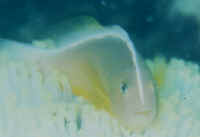
|
| Amphiprion chrysopterus Cuvier 1830, the
Orange-Fin Anemonefish. West to mid Pacific; Australia, New Guinea,
Marshall Islands, Tuamotus. Yellowish-orange accents on upper and
lower body and yellow tail. To six inches. Found in three species
of anemones in the wild. Some in captivity. |
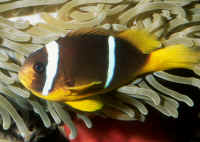 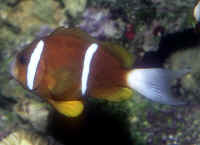
|
| Amphiprion clarkii (Bennett 1830), Clarkii
or Yellowtail Clownfish. Indo-West Pacific; Persian Gulf to Western
Australia to Melanesia, Micronesia. To six inches in length. The
most variable species of the subfamily. Blackish to brown body
color, third white body bar on caudal peduncle, white or yellow
tail. At right in N. Sulawesi. Below: Juvenile in Queensland
Australia, adult in the Maldives (typical dark color as with most
individuals found with Stichodactyla mertensii), and lastly
aquarium image. |
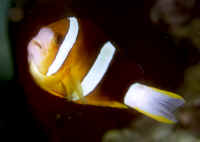
|
| Amphiprion ephippium (Bloch 1790), the Red
Saddle Anemonefish. Eastern Indian Ocean; Andaman and Nicobar
Islands, Thailand, Malaysia, Java and Sumatra in Indonesia. To five
and a half inches maximum length. This three inch female in the
Singapore Aquarium. Body, fins orange to reddish. |
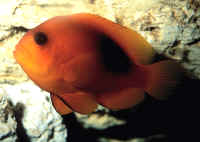
|
| Amphiprion frenatus
Brevoort 1856, the Tomato Clownfish. Found in several island groups
in the Western Pacific. To five and a half inches in length in the
wild. This one in Australia with a Bubble Tip Anemone,
Entacmaea quadricolor which the species most often
pairs with. Similar to A. melanopus, but with a narrower white
head band. |
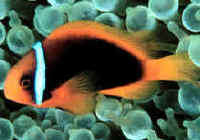
|
|
Amphiprion melanopus Bleeker 1852, the Red
and Black Anemonefish, Melanopus Clown. Variable amounts of red
and black, with or w/o a "Tomato Clown" like single
white head bar. Indonesia, to the Society and Marshall Islands.
To nearly five inches in length. Most often found with
Entacmaea quadricolor as anemone symbiont. Here in
Queensland and N. Sulawesi.
|
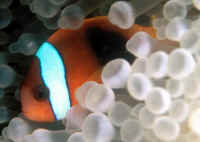 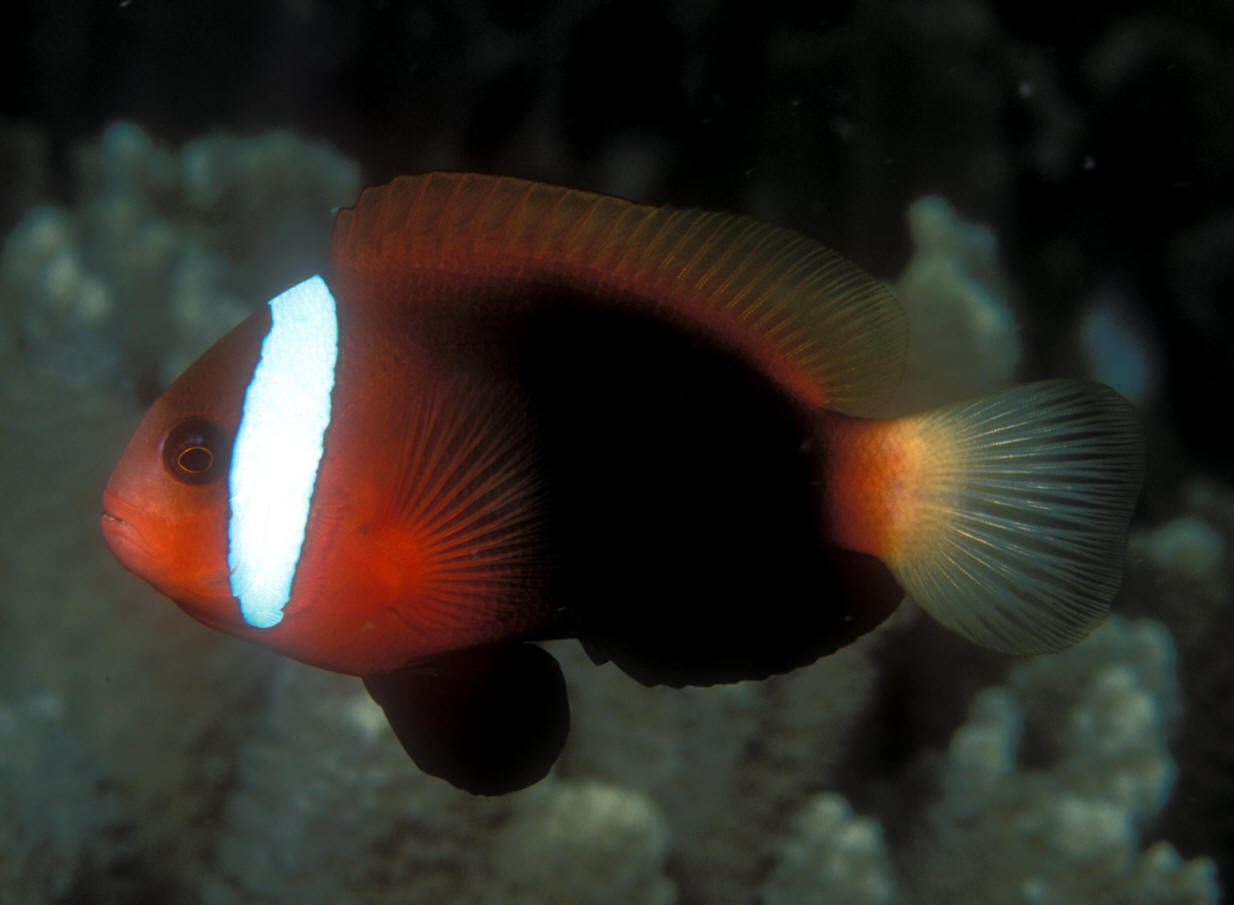
|
| Amphiprion ocellaris Cuvier 1830, the
"False" Percula or Clown Anemonefish, or Ocellaris Clown.
Indo-West Pacific; eastern Indian Ocean to Australia, to
Philippines, to southern Japan. To a little over four inches
maximum length. Bred in captivity including beautiful northwest
Regular and Australian dark variety mid-juvenile and adult
below. Orange overall (except for melanistic forms), with
three broad continuous body bars with narrow black margins (vs.
thick ones in A. percula). |
| Amphiprion percula (Lacepede 1802), the
"True" Percula or Orange Clownfish. Western Pacific; New
Guinea, GBR, Solomon Islands, Melanesia. To about four inches in
length. Mutualistic with Stoichactis and Radianthus
anemones. |
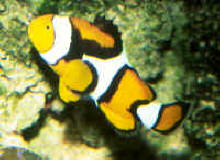
|
| Amphiprion perideraion Bleeker 1855, the
Pink Anemonefish. Indo-Pacific. To four inches in length. Narrow
midline white stripe and head barring. One in a Heteractis
magnifica in Western Australia, another in Mabul,
Malaysia. |
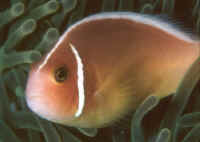 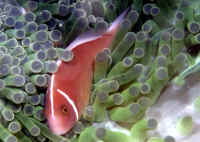
|
| Amphiprion polymnus (Linnaeus 1758), the
Saddleback Clownfish. Western Pacific; Ryukyu Islands to the Gulf
of Thailand, Indonesia. Northern Australia and Solomon Islands. To
five inches in length. Distinctive saddle-like marking on mid-body.
This pair in a typical silty/sandy setting in a Stichodactyla
haddoni anemone (also inhabits Heteractis crispa in the
wild), off Pulau Redang, Malaysia, and in an aquarium. Below, some
darker different colored ones from N. Sulawesi. |
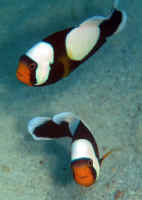 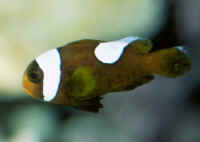
|
| Amphiprion sandaracinos Allen 1972, the
Yellow or Eastern Skunk Clownfish. Indo-West Pacific; Christmas
Island and Western Australia in the eastern Indian Ocean to the
Ryukyu and Solomon Islands in the western Pacific. Note the
orange body color and wide white stripe that extends down to the
upper lip, differentiating this from other "Skunk
Clowns". One in Pulau Redang, Malaysia, another in N.
Sulawesi. |
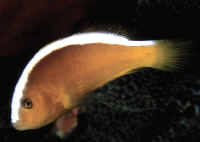 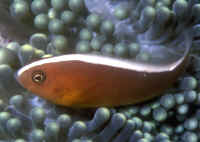
|
| Amphiprion sebae Bleeker 1853, the Sebae
Clownfish. Dark brown to black, two wide white body bars, the
second slanting backward on the upper flank, extending to end of
dorsal fin. Orange to yellow tail. To five inches in length. Most
often fishes sold under this name in the pet-fish trade are
actually Clark's Clownfish. Found all along the northern Indian
Ocean. Here in N. Sulawesi, with eggs and a Haddoni carpet
anemone. |
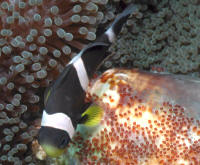
|
Genus Premnas:
| Premnas biaculeatus (Bloch 1790), the
Spine-Cheek Anemonefish, Maroon Clownfish. Bright red to orange
body and fins, with three narrow white body bars and prominent
opercular spine. Females to six inches, males about half that
size. |
|
|

